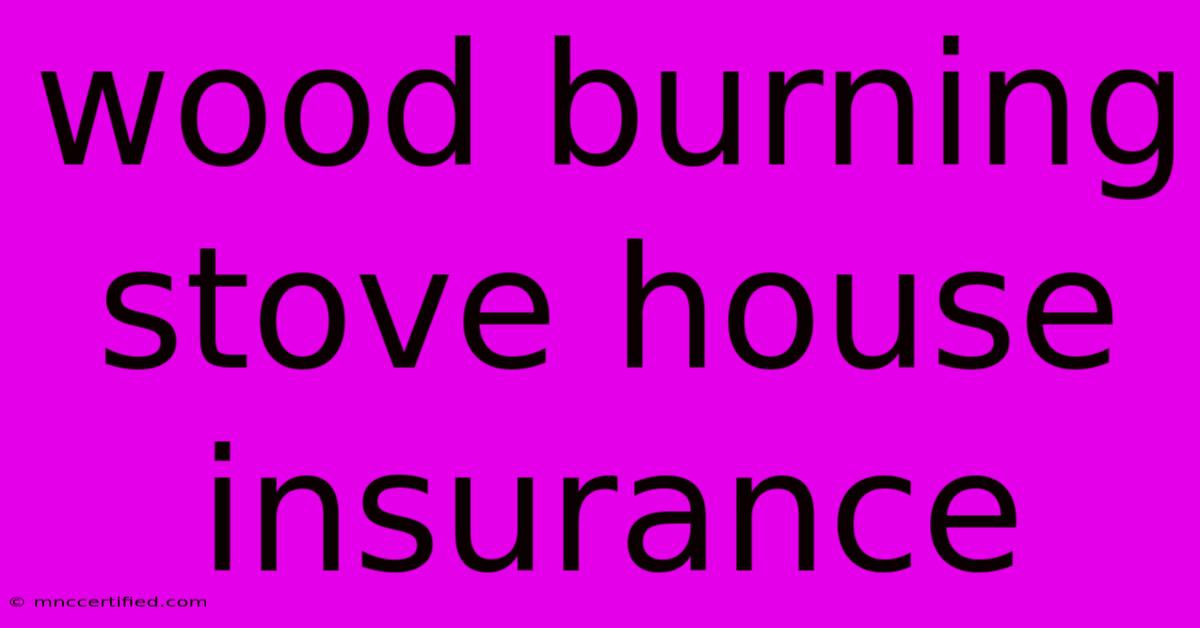Wood Burning Stove House Insurance

Table of Contents
Wood Burning Stove House Insurance: A Complete Guide
Getting a wood-burning stove can dramatically increase the warmth and ambiance of your home. However, it also presents a potential fire risk, significantly impacting your home insurance premiums. Understanding how wood-burning stoves affect your insurance and taking the necessary precautions is crucial. This comprehensive guide will help you navigate the complexities of wood burning stove house insurance.
Understanding the Risks
Insurance companies assess risk when determining your premiums. Wood-burning stoves, while offering cozy warmth, inherently increase the risk of fire damage. Factors contributing to this increased risk include:
- Improper Installation: Incorrect installation is a major cause of stove-related fires. A poorly installed chimney can lead to creosote buildup, increasing the chance of a chimney fire.
- Lack of Maintenance: Regular cleaning and maintenance are vital. Accumulated creosote is highly flammable and can easily ignite. Ignoring maintenance significantly increases the risk.
- Incorrect Operation: Operating the stove incorrectly, such as overloading it with fuel or leaving it unattended, can also lead to accidents.
How Wood Burning Stoves Affect Your Insurance Premium
The impact on your insurance premium depends on several factors:
- Type of Stove: The type of stove plays a role. Modern, certified stoves with safety features generally attract lower premiums than older, less regulated models.
- Installation: Professional installation by a qualified installer significantly reduces the risk and can positively impact your premium. Always ensure you obtain certification and keep records of the installation.
- Location: The location of the stove within the house can influence the risk assessment.
- Insurance Provider: Different insurers have varying risk assessments and premium structures. Comparing quotes from multiple providers is essential.
Finding the Right Insurance:
Shopping around for insurance is crucial. Don't just stick with your current provider; contact several insurers and explicitly mention your wood-burning stove. Be prepared to provide details about:
- Stove Make and Model: Provide the exact make and model of your stove for accurate risk assessment.
- Installation Details: Provide details of the installation, including the installer's qualifications and certification.
- Maintenance Schedule: Outline your planned maintenance schedule, demonstrating your commitment to safety.
Minimizing Risk and Reducing Premiums
Taking proactive steps to mitigate risk can significantly reduce your insurance premiums:
- Professional Installation: Always opt for professional installation by a certified installer. This significantly reduces the risk and can be a persuasive factor for insurers.
- Regular Maintenance: Schedule regular chimney sweeping and stove maintenance. Keep detailed records of these services.
- Smoke Detectors: Ensure you have working smoke detectors throughout your home, especially near the stove and chimney.
- Fire Extinguisher: Keep a fire extinguisher readily accessible near the stove.
- Fire Guard: Using a fire guard can offer added protection, especially if there are children or pets in the house.
- Proper Fuel: Only use the recommended type and amount of fuel for your stove.
Key Questions to Ask Your Insurer
Before purchasing a wood-burning stove or renewing your home insurance, ask your insurer these crucial questions:
- Do you insure homes with wood-burning stoves? This seems obvious, but it's a crucial first step.
- What documentation do you require regarding the stove's installation and maintenance? Understanding their requirements upfront saves time and hassle.
- Will my premium increase, and by how much? Get a clear understanding of the potential cost increase.
- What conditions or clauses are included in my policy concerning the wood-burning stove? Be aware of any limitations or exclusions.
- What steps can I take to mitigate the risk and potentially lower my premium? They may suggest specific measures.
By understanding the risks associated with wood-burning stoves and taking proactive measures, you can significantly reduce the chances of an incident and potentially secure more favorable insurance rates. Remember, transparency with your insurer is key to securing appropriate coverage. Don't hesitate to ask questions and ensure you are fully informed before making a decision.

Thank you for visiting our website wich cover about Wood Burning Stove House Insurance. We hope the information provided has been useful to you. Feel free to contact us if you have any questions or need further assistance. See you next time and dont miss to bookmark.
Featured Posts
-
Portugal Vs Poland Live 2 0 Uefa Nations
Nov 16, 2024
-
Stream Jake Paul Tyson Fight Free
Nov 16, 2024
-
Anchor Insurance Muskegon Michigan
Nov 16, 2024
-
Addressing Foreign Bribery In Portugal
Nov 16, 2024
-
Daily Acca 17 2 Nations League Treble
Nov 16, 2024